Jul 28, 2024
Kenya is one of the fastest growing economies in Sub-Saharan Africa, having registered a growth rate of 5.0% in the first quarter of 2024. Despite being one of the fastest growing economies in Sub-Saharan Africa with a projected economic growth rate of 5.0%, above the region’s average of 3.7%, Kenya is grappling with a high debt burden, facing elevated risk of debt distress and significant challenges in managing its public debt, which has increased rapidly in recent years. As per the latest data from the Central Bank of Kenya (CBK), the total public debt stood at Kshs 10.6 tn as of June 2024, compared to Kshs 10.3 tn recorded in June 2023. Notably, external debt reduced by 5.2% during the period to Kshs 5.2 tn in March 2024, from 5.4 tn in June 2023 attributable to the early partial repayment of the USD 2.0 bn Eurobond in February 2024. Consequently, the debt to GDP ratio has increased to 70.0% as of June 2024, 20.0% points higher than the International Monetary Fund (IMF) threshold of 50.0% for developing countries, though slightly down from the 70.8% recorded in June 2023. The government has been working on trimming the domestic borrowing so as to alleviate the pressure on interest rates, with the short-day papers all crossing the 16.0% mark in the recent auctions. Furthermore, following the withdrawal of the Finance Bill 2024, which aimed to raise Kshs 344.3 bn in additional revenues, the government has outlined plans to adjust the FY’2024/25 Budget to align with the Revised Fiscal Framework and implement expenditure cuts so as to reduce the fiscal deficit. Reducing local borrowing also aims to address the crowding out of the private sector. External debt primarily comes from multilateral and bilateral creditors, while domestic debt consists mainly of Treasury bonds and Treasury bills. Likewise, the debt service to revenue ratio has increased over the period to 69.6% as of June 2024, 39.6% points higher than the IMF threshold of 30.0%. Notably, the debt service to revenue ratio hit an all-time high of 101.4% as of July 2023, indicating the growing burden of debt servicing that continues to weigh on the government’s expenditure.
The rising public debt has raised concerns about its sustainability and implications for fiscal and macroeconomic stability. These concerns have seen credit rating agencies such as Fitch, Moody’s and S&P Global maintaining Kenya’s credit outlook at negative, resulting in higher borrowing costs in the international market. Notably, earlier this month, Moody’s downgraded Kenya’s credit score by one scale to Caa1, from B3 on the back of the country’s ability to implement its fiscal consolidation measures focused on revenue, which are necessary to reduce overall debt. Additionally, S&P Global has scheduled a review on 23rd August 2024 to decide on Kenya’s sovereign credit rating. The firm may either downgrade Kenya’s B credit score to B- or maintain the current rating but keep it on downgrade warning with a negative outlook. S&P Global is adopting a wait-and-see approach to gain more clarity on the appropriation bill, spending allocations, the final budget, and the finance bill. With the withdrawal of the planned tax increases, the Kenyan government faces the challenge of prolonged fiscal deficits, which could further deteriorate the government’s public debt situation and worsen the debt vulnerability of Kenya.
We have been tracking the evolution of the public debt and below are the most recent topicals we have done on Kenya’s debt:
- Kenya's Public Debt Review 2023: Is Kenya's Public Debt Level Sustainable- In April 2023, we highlighted the state of affairs concerning the country’s public debt and concluded by discussing strategies that the government could implement in order to reduce the economic consequences of high debt levels as well as mitigate the high risk of debt distress,
- Kenya’s Public Debt 2022; Debt Service Coverage- In July 2022, In December 2016, we wrote about Kenya’s debt level, questioning its sustainability, and concluded that the government needed to reduce the amount of public debt, giving suggestions as to how this could be achieved, and,
- Kenya’s Public Debt: On a path to Distress?- In October 2021, we highlighted the state of affairs concerning the country’s public debt profile and levels and concluded that Kenya’s risk of debt distress remained elevated,
- Kenya’s Public Debt Review 2023 – In October 2023, we highlighted Kenya’s public debt situation and the need for prudent fiscal management and strategic planning to ensure that the debt remains sustainable and does not compromise the country’s economic prospects.
In this week's topical, we will focus on the current status of Kenya's public debt at the end of FY’2023/2024. We will examine the economic consequences of high debt levels and provide our outlook on the country's debt sustainability following the withdrawal of proposed tax increases. Instead, the government is now focusing on expenditure cuts to reduce fiscal deficits. Additionally, the report will compare Kenya's public debt situation with that of other Sub-Saharan countries using various indicators such as the debt-to-GDP ratio and the debt service-to-revenue ratio.
This we shall cover as follows;
- The Current State of Kenya’s Public Debt,
- Kenya’s Debt Servicing Cost,
- Economic Impact of Kenya’s High Debt Levels,
- Kenya’s Debt Sustainability Analysis and Projection,
- Comparative Analysis with Regional Peers, and,
- Policy Recommendations and Conclusion.
Section I: The Current State of Kenya’s Public Debt
According to the Central Bank of Kenya (CBK) Weekly Bulletin Report, Kenya’s public debt reached Kshs 10.6 tn, (equivalent to 70.0% of GDP) as of end of June 2024, marking a 2.9% increase from the Kshs 10.3 tn (70.8% of GDP) recorded in June 2023. Amidst the government’s fiscal consolidation efforts through expenditure cuts in the budget’s appropriations, so as to stem the escalation of debt accumulations and maintain sustainable debt levels, in the FY’2024/2025 Supplementary Budget Estimates I, total expenditure and net lending were revised to 21.4% of GDP, from the original projection of 22.1% of GDP. However, overall fiscal deficit level inclusive of grants increased by 0.3% points to 3.6% of GDP, from the original projection of 3.3% of GDP. The public debt to GDP ratio is projected to decline to 58.2% in 2024. However, we expect the government efforts to be impeded by the deteriorated macroeconomic environment as evidenced by the decline in Purchasing Manager's Index (PMI) to 47.2 recorded in June 2024, below the 50.0 neutral, down from 51.8 in May 2024, signaling a deterioration in the operating conditions across Kenya, resulting from the recent unrest following the anti-finance bill protests, in addition to the high interest rates from tightening monetary policy and an overall rise in the cost of living. Additionally, the high fuel prices, despite the decline over recent months and slower economic growth is expected to stifle revenue collection. Below is a graph highlighting the trend in the Kenya’s debt to GDP ratio over the last 10 years:
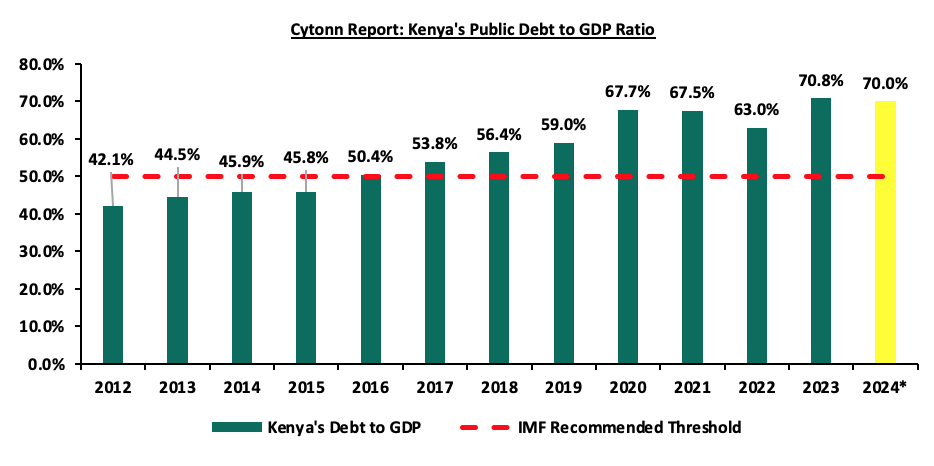
Source: National Treasury
Kenya's debt levels have been rising due to persistent fiscal deficits, which have averaged 7.3% of GDP over the last 10 financial years. This increase is attributed to sustained recurrent expenditures, debt costs and a focus on development projects. Over this ten-year period, government revenue grew at a compound annual growth rate (CAGR) of 8.3%, reaching Kshs 2.4 tn by the end of FY’2023/24, up from Kshs 1.1 tn by the end of FY‘2014/15. However, this revenue growth was outpaced by growth in government expenditure, which grew at a CAGR of 9.0%, reaching Kshs 3.8 tn by the end of FY’2023/24, up from Kshs 1.6 tn in FY’2014/15. The chart below shows the growth in Kenya’s total revenue and expenditure in the last 10 fiscal years:
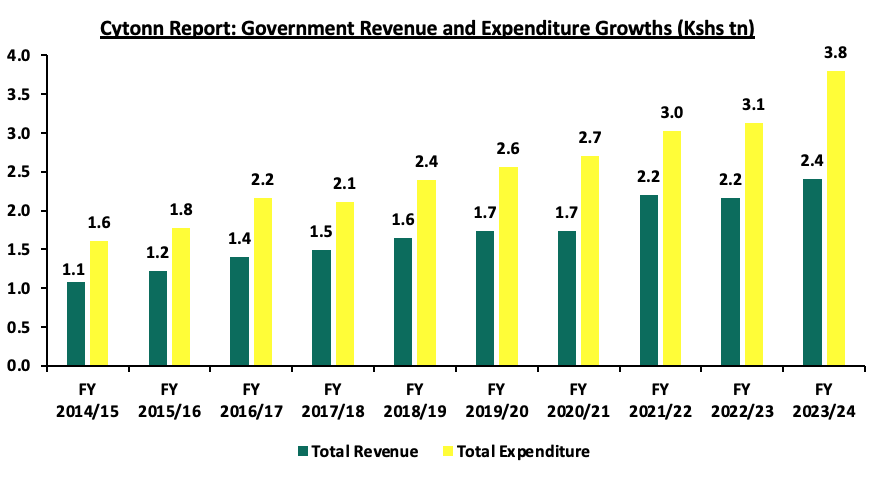
Source: Central Bank of Kenya
- The Nature of Kenya’s Debt Composition (Domestic vs External)
Over the years, Kenya’s debt composition has been evenly distributed between domestic and external borrowing. However, since the beginning of 2023, there has been a shift towards external borrowing with the proportion of external debt against domestic debt standing at 54.7% to 45.3% in December 2023, compared with 51.1% to 48.9% observed over a similar period in 2022. The shift was brought about by the government’s revision of its domestic borrowing target for the FY’2023/24 from the initial Kshs 586.5 bn to Kshs 316.0 bn, a move aimed at mitigating the upward pressure on the domestic borrowing rates while at the same time bolstering foreign reserves by increasing the government’s efforts on sourcing for bilateral and multilateral funding. As of March 2024, the proportion of external debt against domestic debt stood at 49.7% to 50.3%, with the higher domestic debt attributable to the Eurobond repayment. Notably, external debt increased at a 10-year CAGR of 25.0% to Kshs 5.2 tn as at March 2024, from Kshs 1.3 tn in March 2015, higher than the 14.1% CAGR recorded by domestic debt to Kshs 5.2 tn as at March 2024 from Kshs 1.4 tn in March 2015. Consequently, the total public debt has increased at a 10-year CAGR of 14.5% to Kshs 10.4 tn as at March 2024, from the Kshs 2.7 tn recorded as at March 2015. Below is a graph highlighting the trend in the external and domestic debt composition over the last 10 years;
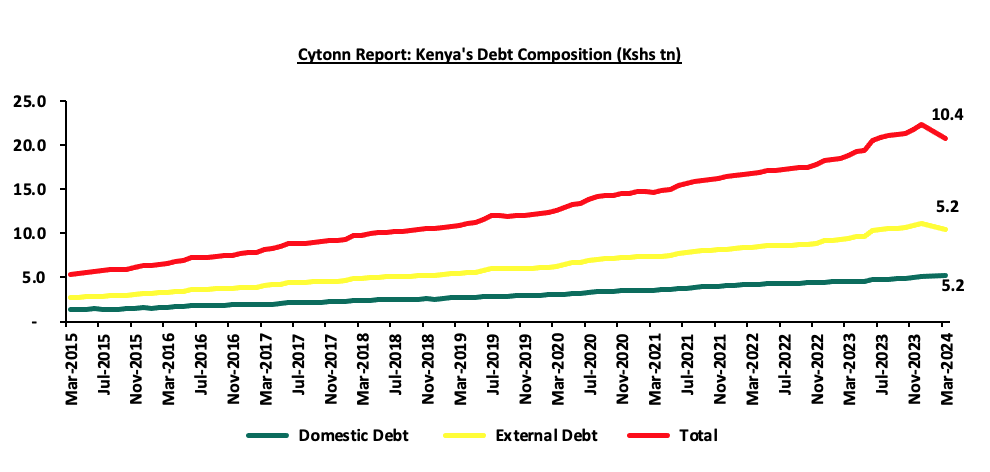
Source: National Treasury and Central Bank of Kenya
Below is a graph highlighting the composition of domestic and external debt as a percentage of total public debt over the last 10 years:

Source: National Treasury and Central Bank of Kenya
- Public Debt Mix by Holders
- External Debt Composition by Holders (Bilateral, Multilateral, and Commercial Banks)
Kenya’s external debt stock is mainly composed of multilateral loans, bilateral loans and commercial loans. According to the CBK Quarterly Economic Review, in the second quarter of FY’2023/2024, Kenya’s exposure to multilateral loans recorded a 2.9% points increase to 50.3%, from 47.4% as at the end of December 2022. This was attributable to favourable terms offered in terms of low interest rates and longer repayment periods, when compared to bilateral loans and commercial loans. Notably, during the third quarter of FY’2023/24, Kenya was able to issue a new Eurobond worth USD 1.5 bn, aimed to facilitate the buyback of the USD 2.0 bn Eurobond originally issued in 2014. In June 2024, Kenya successfully settled the remaining portion of the 2014 Eurobond issue, assuring foreign investors of the country’s broader plan to maintain debt sustainability and manage public debt efficiently. Despite, initial declines following the Eurobond buyback in February, the yields on the Eurobonds have once again shown volatility in recent months, indicating renewed investor concerns over Kenya’s economic stability and debt sustainability. This is attributable to perceived risks associated with Kenya’s economic environment, including fiscal deficits, debt sustainability concerns and the ongoing protests that continue to put pressure on the economy. The chart below shows external debt composition by Creditors:
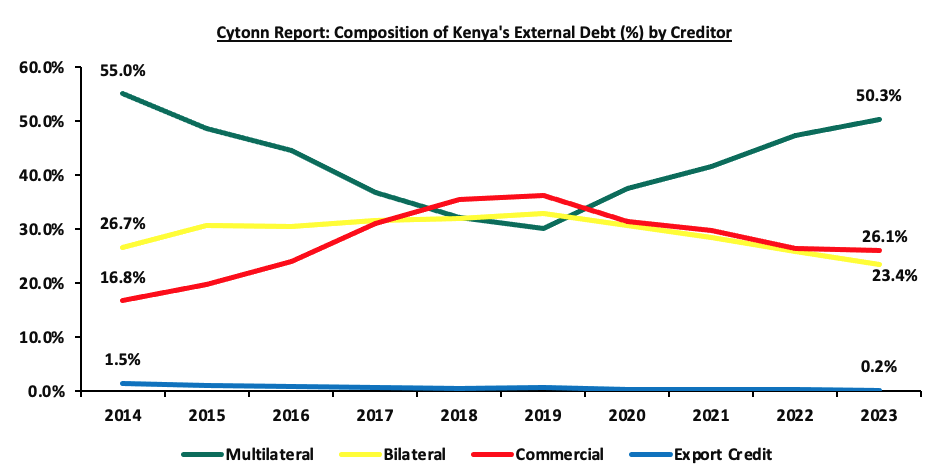
Source: National Treasury, CBK
It is key to note that:
- The portion of multilateral debt increased by 2.9% points to 50.3% in December 2023, from 47.4% recorded over a similar period in 2022, due to disbursements from IMF USD 1.0 bn (Kshs 138.6 bn) under the Development Policy Operation (DPO) from the World Bankand a total of USD 415.4 mn (Kshs 58.9 bn) from the IMF under the Extended Credit Facility arrangement (EFF/ECF) for budgetary support during the period. This was in addition to the USD 551.4 mn (Kshs 78.1 bn) approved under the Resilience and Sustainability Facility (RSF), following the completion of IMF’s fifth review of the 38-months Extended Fund Facility (EFF) and Extended Credit Facility (ECF) financing. Notably, Bilateral debt decreased by 2.9% points to 24.4% in June 2023, from 27.3% in June 2022,
- Commercial debt as a percentage of external debt reduced by 0.4% points to 26.1% of total external debt in December 2023 from 26.5% in December 2022, mainly attributable to Kenya’s government shunning away from the more expensive debt due to the prevailing market conditions, and,
According to the CBK Quarterly Economic Review as at December 2023, 67.3% of the external debt was US Dollar denominated contributing to the increasing debt servicing cost given the shilling’s depreciation having lost against the USD by 26.8% as of December 2023. The table below shows the currency composition of the external debt stock:
|
Cytonn Report: Currency composition of the External Debt Stock (%) |
||
|
Currency |
December-2022 |
December-2023 |
|
USD |
68.1% |
67.3% |
|
EUR |
19.8% |
21.4% |
|
Yuan |
5.4% |
5.1% |
|
Yen |
4.2% |
3.8% |
|
GBP |
2.4% |
2.2% |
|
Other Currencies |
0.2% |
0.2% |
Source: Central Bank of Kenya
- During the week, Treasury released the Public Debt Management Office Report as of June 2023, noting that, for multilateral debt, the International Development Association (IDA) was the largest creditor, with debt increasing by 29.3% to Kshs 1,573.6 bn as at June 2023, from Kshs 1,217.2 bn as of June 2022 making up 59.3% of the total multilateral debt. The International Monetary Fund (IMF) was the second largest creditor, with debt increasing by 62.6% to Kshs 335.6 bn as at June 2023, from Kshs 206.4 bn as at June 2022 equivalent to 12.6% of the total multilateral debt. The International Bank for Reconstruction & Development (IBRD) accounted for 2.8% of the total multilateral, increasing significantly by 126.8% to Kshs 152.2 bn as of June 2023, from Kshs 67.1 bn in FY’2021/22. The table below shows the source composition of multilateral debt stock for the FY’2021/22 and FY’2022/23:
|
Cytonn Report: External Multilateral Debt Stock by Source (Kshs bn) |
||||
|
Currency |
Jun-2022 |
Jun-2023 |
% Change |
Proportion (%) |
|
International Development Association |
1217.2 |
1573.6 |
29.3% |
59.3% |
|
International Monetary Fund |
206.4 |
335.6 |
62.6% |
12.6% |
|
African Development Fund |
259.4 |
314.0 |
21.0% |
11.8% |
|
African Development Bank |
125.9 |
203.9 |
61.9% |
7.7% |
|
Intl Bank for Reconstruction & Development |
67.1 |
152.2 |
126.8% |
5.7% |
|
Others |
56.7 |
75.6 |
33.4% |
2.8% |
|
Total |
1932.7 |
2654.9 |
37.4% |
100.0% |
Source: Public Debt Management Office Report FY’2022/23
- For bilateral debt, the largest creditor was the Exim Bank of China, which increased its debt by 8.9% to Kshs 880.9 bn as at June 2023, from Kshs 809.2 bn as at the end of FY’2021/22 representing 70.5% of the total bilateral debt in FY’2022/2023. The total bilateral debt rose by 10.8% to Kshs 1,248.6 bn from Kshs 1,127.3 bn as at the end of FY’2021/22, showing an increase in overall borrowing. The table below shows the source composition of the bilateral debt stock for the FY’2021/22 and FY’2022/23:
|
Cytonn Report: External Bilateral Debt Stock by Source (Kshs bn) |
||||
|
Currency |
Jun-2022 |
Jun-2023 |
% Change |
Proportion (%) |
|
Exim Bank of China |
809.2 |
880.9 |
8.9% |
70.5% |
|
Agence Francaise De Development |
85.3 |
100.0 |
17.2% |
8.0% |
|
Government of Japan |
85.9 |
99.1 |
15.4% |
7.9% |
|
Unicredit SPA |
53.0 |
52.8 |
-0.3% |
4.2% |
|
Govt of Fed. Reublic of Germany |
34.6 |
44.7 |
29.3% |
3.6% |
|
Others |
59.3 |
71.0 |
19.8% |
5.7% |
|
Total |
1127.3 |
1248.6 |
10.8% |
100.0% |
Source: Public Debt Management Office Report FY’2022/23
- Domestic Debt Composition by Holders
Banking institutions make up for the highest percentage of domestic debt, accounting for 45.5% of government securities holdings as at 24th July 2024, 0.6% points lower than the 46.1% share recoded as at the end of the second quarter of FY’2023/24, with the increase mainly attributed reduced credit risk. On the other hand, government securities holding by other domestic investors registered 1.6% points increase to 12.9% as at 24th July 2024, from the 11.3% recorded at the end of December 2023. Notably, pension funds accounted for the second largest portion with 29.3% of holdings in government securities as at 24th July 2024, albeit 0.6% points lower than the 29.9% registered in December 2023. Below is a table of the composition of government domestic debt by holders:
|
Cytonn Report: Composition of Government Domestic Debt by Holder |
||||||||||||
|
Domestic debt |
Dec-13 |
Dec-14 |
Dec-15 |
Dec-16 |
Dec-17 |
Dec-18 |
Dec-19 |
Dec-20 |
Dec-21 |
Dec-22 |
Dec-23 |
July-24 |
|
Banking institutions |
49.2% |
54.3% |
55.4% |
52.2% |
54.6% |
54.5% |
54.3% |
53.3% |
50.2% |
46.8% |
46.1% |
45.5% |
|
Insurance Companies |
10.2% |
9.9% |
8.4% |
7.3% |
6.4% |
6.1% |
6.4% |
6.4% |
6.8% |
7.4% |
7.2% |
7.2% |
|
Parastatals |
3.5% |
2.8% |
4.6% |
5.8% |
6.9% |
7.3% |
6.5% |
5.7% |
5.6% |
6.1% |
5.5% |
5.1% |
|
Pension Funds |
26.1% |
23.9% |
25.4% |
28.2% |
27.5% |
27.6% |
28.6% |
30.3% |
31.3% |
33.3% |
29.9% |
29.3% |
|
Other domestic investors |
11.0% |
9.0% |
6.2% |
6.5% |
4.6% |
4.6% |
4.2% |
4.3% |
6.1% |
6.4% |
11.3% |
12.9% |
|
TOTAL |
100.0% |
100.0% |
100.0% |
100.0% |
100.0% |
100.0% |
100.0% |
100.0% |
100.0% |
100.0% |
100.0% |
100.0% |
Source: Central Bank of Kenya
- GDP per Capita vs Debt per Capita
According to Central Bank data, Kenya’s Public Debt per Capita has increased at a 10-year CAGR of 15.7% to Kshs 202,169.2 in 2023, from Kshs 47,140.9 in 2013. Conversely, GDP per Capita has grown at a slower 10-year CAGR of 8.7% to Kshs 274,202.6 in 2023, from Kshs 118,576.5 in 2013. This discrepancy suggests that the rapid increase in public debt is not being matched by corresponding economic growth. The chart below compares Kenya’s GDP per capita to the debt per capita over the last 10 years:
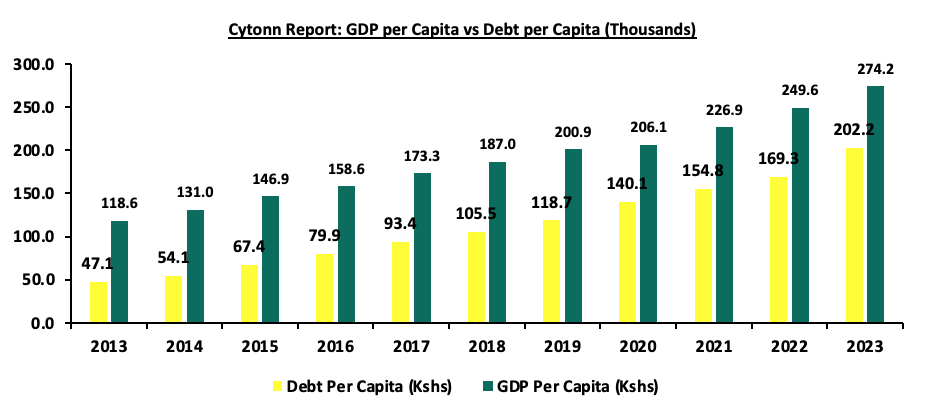
Source: World Bank, CBK
Factors that have accelerated the growth in Kenya’s Public debt;
- Fiscal Deficit – Kenya has witnessed a persistent fiscal deficit averaging at 7.5% of the GDP for the last 10 financial years and is projected to ease to 3.6% of the GDP at the end of FY’2024/25, from the 5.7% recorded in FY 2023/24. According to the revised Budget Estimates for FY'2024/25 the approved budget for the FY’2024/25 is estimated to be Kshs 3.9 tn against a targeted revenue collection of Kshs 3.1 tn, hence the need to borrow an additional Kshs 0.4 tn domestically and Kshs 0.3 tn externally,
- Debt Servicing Costs – Debt servicing cost has been on the rise, with the debt service to revenue ratio averaging 23.5% over the last 10 financial years and standing at 69.6% as of June 2024. The rising debt servicing cost is attributed to the continuous accumulation of total public debt, resulting from the increased flow of international development assistance in the form of concessional loans,
- Short falls of Revenue collections – Despite the significant growth in tax revenues, the Kenya Revenue Authority (KRA) has consistently fallen short of its tax revenue targets, with the tax collections for FY'2023/24 increasing by 11.1% to Kshs 2.4 tn from Kshs 2.2 tn in FY’2022/23, albeit short of the Kshs 2.5 tn target. To plug the budget deficits, the government has had to borrow externally and also from the domestic market thereby increasing the country’s debt profile over time, and,
- Guaranteed loans by the Government of Kenya – The guaranteed loans on state corporations put pressure on the need for excessive spending, despite poor performances by the said state corporations.
Section II: Kenya’s Debt Servicing Cost
According to the Revenue and Net Expenditures Report for the FY’2023/24 by the National Treasury, the cumulative public debt servicing cost amounted to Kshs 1,596.6 bn which was 89.6% of the revised estimates of Kshs 1,782.4 bn, and 91.2% of the original estimates of Kshs 1,751.1 bn. Notably, the Kshs 1,596.6 bn debt servicing cost was equivalent to 69.6% of the actual revenues of Kshs 2,292.0 bn collected as at the end of FY’2023/24, which was 39.6% points above IMF’s recommended threshold of 30.0%. The sustained high debt service to revenue ratio above the recommended threshold is a worrying sign, with a large proportion of the government’s revenue being allocated to servicing debt rather than being available for other essential expenditures. A ratio of above 50.0% means that more than half of the government's revenue is being allocated to servicing debt which may leave limited fiscal space for public investments, social programs, and other critical government functions, which are essential for the long-term well-being of the country, as a significant part of the budget is pre-committed to debt repayment. Below is a chart showing the debt service to revenue ratio for the last ten fiscal years:
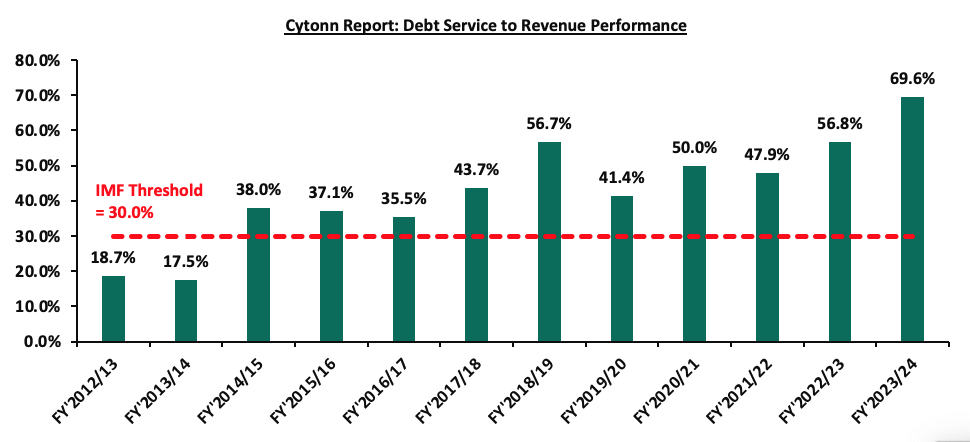
Source: National Treasury
Kenya’s debt servicing costs have continued to increase over time growing at a 10-year CAGR of 23.5% to Kshs 1,201.0 bn in FY’2022/2023, from Kshs 145.2 bn in FY’2022/2023. The graph below compares the domestic debt servicing cost to the external debt servicing cost over the last ten fiscal years:
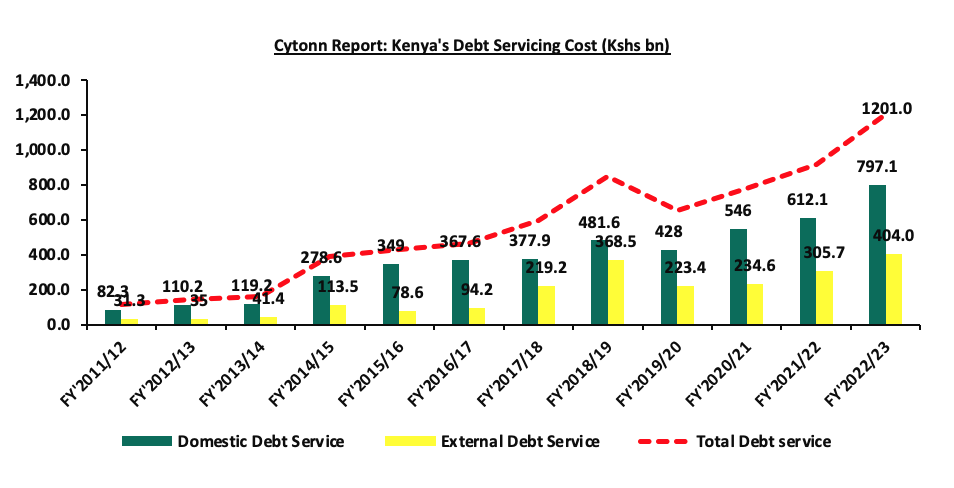
Source: National Treasury
The key take-outs from the chart include:
- Total debt service for the FY’2022/23 stood at Kshs 1,201.0 bn, a 30.9% increase from Kshs 917.8 bn recorded in FY’2021/22. Domestic debt service took the largest share, accounting for 66.4% of the total debt service, equivalent to Kshs 797.1 bn, while external debt service represented 33.6%, equivalent to Kshs 404.0 bn in FY’2022/23, and,
- Interest payments made up the bulk of Kenya’s debt servicing costs coming in at Kshs 689.0 bn, equivalent to 57.4% of the total debt service in FY’2022/2023, higher than the Kshs 578.0 bn worth of interest payments in FY’2021/2022 and equivalent to 63.0% of the total debt service costs as at June 2022. Notably, the domestic interest payments came in at Kshs 533.1 bn, while the external interest payment was Kshs 155.9 bn in FY’2022/2023.
Section III: Economic Consequences of High Debt Levels
The COVID-19 pandemic left numerous sub-Saharan African countries grappling with a fragile global economy, escalating prices, costly loans, and a high cost of living. Many of these nations continue to face challenges like high inflation, elevated interest rates, currency fluctuations, and political instability. Consequently, many developing countries, including Kenya, have had to increase borrowing to shield their economies from additional economic shocks caused by internal geopolitical tensions and supply chain disruptions amid emerging global conflicts. However, this ongoing borrowing has led to significant debt accumulation, posing several implications for the Kenyan economy.
- Impact on currency value-High debt levels can lead to a depreciation of the national currency. Investors may lose confidence in the country's ability to manage its debt, leading to capital flight and a weaker currency. A depreciated currency can increase the cost of imports, contributing to inflationary pressures,
- Increased Debt Servicing Costs – High debt levels have led to increased costs of debt servicing given that a significant portion of the debt is in foreign currencies despite the fact that the Kenyan Shilling has been strengthening. The government has had to increase taxes and cut spending in other areas to meet its debt obligations and the conditions set by Multilateral lenders such as the IMF,
- Higher Borrowing Costs on New Loans – Given the country’s high levels of debt, lenders perceive Kenya’s credit environment to be riskier, therefore demanding higher interest rates for new borrowing. This makes it more expensive for the government to finance its operations and investments,
- Reduced Fiscal Space – High debt levels tend to limit a government’s fiscal space, or its ability to respond to economic shocks with fiscal policy. This is because a large portion of the government’s budget gets tied up in debt servicing, leaving less money for other expenditures and development,
- Crowding Out of the Private Sector – Because of the increased domestic borrowing, the government crowds out the private sector by driving up interest rates in the economy thus making it difficult for both businesses and individuals to borrow, and,
- Risk of Default – High levels of debt can lead to default, where a country is unable to meet its debt obligations. For Kenya’s situation, credit rating agencies such as Fitch and Moody’s have downgraded the country’s credit outlook from stable to negative resulting in increased borrowing costs and loss of investor confidence.
Section IV: Kenya’s Debt sustainability Analysis and Outlook
As discussed in above sections, the country’s risk of debt distress remains elevated as evidenced by the high debt service to revenue ratio of 69.6% as of June 2024. Additionally, Kenya’s debt to GDP ratio currently stands at 70.0%, 20.0% points above IMF’s recommended threshold of 50.0% for developing countries. Notably, Kenya’s public debt recorded a 5-year CAGR of 10.1% to Kshs 10.6 tn in June 2024, outpacing the economic growth’s 5-year average of 4.6%, with the International Monetary Fund (IMF) projecting Kenya’s 2024 GDP growth to come in at 5.0% as of January 2024, a downward revision from its projection of 5.3% made in July 2023 as a result of high interest rates and domestic shocks in emerging economies in the G20 such as China, whose spills over effects are being projected to impact Kenya’s economic output. The persistent fiscal deficits resulting from the revenue-expenditure mismatch continue to hamper fiscal consolidation efforts as revenue continues to lag behind expenditure.
Kenya’s debt levels have been of concern, with the recent ratings by S&P Global, Fitch and Moody’s credit agencies downgrading the country’s credit outlook from stable to negative. Notably, on July 8th 2024, Moody’s announced its revision of Kenya’s credit score, downgrading it by one scale to Caa1 from a credit rating of B3 while maintaining a negative outlook, on the back of the government's decision to forgo proposed tax increases through the Finance Bill 2024 and rely on expenditure cuts, significantly impacting Kenya's fiscal trajectory and financing needs. The downgrades of Kenya’s credit score have dimmed the country’s ability to access cheaper loans in the international financial markets. Below is a summary of the credit rating on Kenya by various rating agencies;
|
Cytonn Report: Kenya Credit Rating Agencies Ratings |
|||||
|
Rating Agency |
Previous Rating |
Previous Outlook |
Current Rating |
Current Outlook |
Date Released |
|
Moody's Rating |
B3 |
Negative |
Caa1 |
Negative |
8th July, 2024 |
|
Fitch Ratings |
B |
Negative |
B |
Negative |
16th February 2024 |
|
S&P Global |
B |
Negative |
B |
Negative |
9th February 2024 |
Source: Fitch Ratings, S&P Global
With the tough macro-economic environment currently being witnessed in the country, the government’s projection of increased revenues especially through tax collection may fall short of its target, thus leading to continuous need for borrowing. The table below gives the trend of both expenditure and revenue growths in the last five financial years and projections in the medium term;
|
Cytonn Report: Public Debt (Kshs tn) |
|||||||
|
FY'2019/20 |
FY'2020/21 |
FY'2021/22 |
FY2022/23 |
*FY2023/24 |
**FY2024/25 |
**FY2025/26 |
|
|
Cumulative Domestic Debt |
3.2 |
3.7 |
4.3 |
4.8 |
5.4 |
5.9 |
6.4 |
|
Cumulative External Debt |
3.4 |
3.8 |
4.3 |
5.4 |
5.2 |
5.8 |
6.0 |
|
Total |
6.5 |
7.5 |
8.6 |
10.3 |
10.6 |
11.7 |
12.4 |
|
Expenditure |
2.6 |
2.8 |
3.0 |
3.2 |
3.8 |
3.9 |
4.5 |
|
Revenue Collected |
1.6 |
1.6 |
1.9 |
2.1 |
2.3 |
3.0 |
3.3 |
|
Budget Deficit |
1.0 |
1.2 |
1.1 |
1.1 |
1.5 |
1.2 |
1.2 |
|
Domestic Borrowings |
0.5 |
0.6 |
0.6 |
0.5 |
0.7 |
0.4 |
0.6 |
|
External Borrowings |
0.3 |
0.3 |
0.1 |
0.3 |
0.3 |
0.3 |
0.3 |
|
Total |
0.8 |
1.0 |
0.7 |
0.8 |
1.0 |
0.7 |
0.9 |
|
Domestic debt service |
0.4 |
0.5 |
0.6 |
0.8 |
1.3 |
1.1 |
|
|
External debt Service |
0.2 |
0.2 |
0.3 |
0.4 |
0.6 |
0.7 |
|
|
Total Debt Service |
0.7 |
0.8 |
0.9 |
1.2 |
1.6 |
1.9 |
1.8 |
|
Debt service to Revenue |
41.4% |
50.0% |
47.9% |
56.0% |
69.6% |
63.4% |
53.5% |
*Provisional data as per the June 2024 Exchequer Issue
**Projected data
Source: National Treasury (Annual Public Debt Management Report and Budget Policy Statement)
Key take outs;
- Debt servicing costs are expected to remain high in the FY’2023/24 due to the need for more borrowings. The high borrowings are expected to be channelled to debt repayment, financing the increasing fiscal deficit as KRA lags behind the target and the depreciating shilling continues to increase debt repayment costs,
Our View: Debt service is projected to grow in FY’2024/25 with debt servicing costs remaining high due to the continued local and external debt maturities,
- Revenue is expected to grow at a 5-year CAGR of 13.9% to Kshs 3.7 tn by the end of FY’2025/26, from Kshs 1.9 tn in FY’2021/22, attributable to the government’s focus to increased tax revenues. Due to the unfavourable business climate, combined with high inflation, the withdrawal of the Finance Bill 2024 and limited liquidity in the country, it is anticipated that revenue collections will not meet the target. Consequently, the success of revenue collection is heavily reliant on the country’s economic performance and how quickly the business environment improves,
- Compared to revenue, expenditure is expected to grow at a relatively slower 5-year CAGR of 8.0% to Kshs 4.5 tn by the end of FY’2025/26, from 3.0 tn recorded in FY’2021/22, on the back of increased recurrent expenditure and persistent current account deficit, and,
- The budget deficit is expected to narrow in the projected years as revenue is projected to increase at a faster rate compared to expenditure. The persistent budget deficit in the projected financial years, is an indication of the need for further borrowing, impeding the government’s in managing the current debt level.
It is clear that the government faces challenges on how they shall finance their operations in the next couple of months as the debt servicing is high and the economic activity is much slower. The KRA collections for the FY’2023/24 amounted to Kshs 2.4 tn, falling short of the tax revenue target of Kshs 2.5 tn, mainly attributed to the tough macroeconomic situation in the country. The situation is exacerbated by the government's decision to forgo proposed tax increases through the Finance Bill 2024 and rely on expenditure cuts, significantly impacting Kenya's fiscal trajectory and financing needs. As a result, the government’s capability to repay its upcoming maturities and meet its debt obligations is still a major concern.
Section V: Comparison with other African countries
Kenya's elevated debt situation is part of a broader trend seen across the sub-Saharan region, where debt levels remain high. According to World Bank’s International Debt Statistics, Africa's debt-to-GDP ratio reached 68.6% at the end of 2023, with 75.0% of this debt being long-term. Notably, 67.0% of the continent's debt is concentrated in just ten countries. Egypt leads with 14.5% of Africa's total debt, followed closely by South Africa at 14.3%. Kenya accounts for 3.7% of the continent's debt, while Tunisia, Sudan, and Ghana each hold between 3.0% and 3.4%. This concentration of debt among a few countries highlights the significant financial pressures faced by these economies within the region. The graph below highlights the composition of the debt by the top 10 countries as a percentage of total region debt:
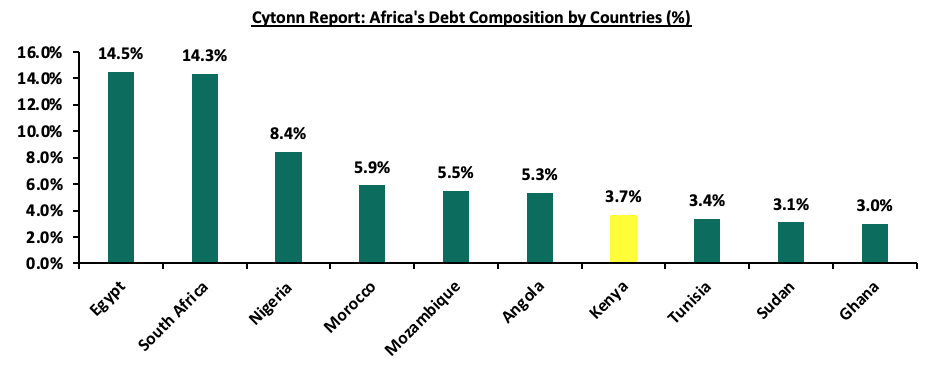
Source: Afrexim Bank Research
Currently, China makes up the largest portion of Africa’s debt stock, and is Africa’s biggest bilateral lender. As of 2023, China held almost USD 24.4 tn of Africa’s external debt. The graph below shows Africa’s debt to China in the last 15 years:
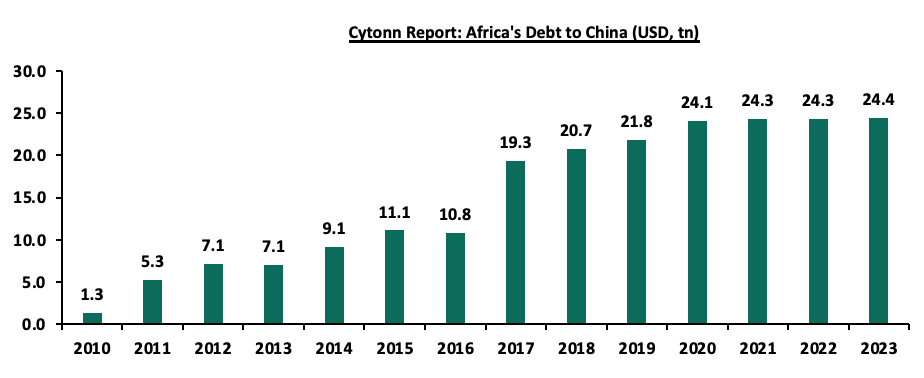
Source: International debt statistics
Additionally, Africa’s debt to service ratio came in at 19.6% in 2023 according to the African Export-Import bank report, with 34 countries recording an increase in the ratio during the year. A high debt service to revenue ratio indicates vulnerability of the country and increased unsustainability of the country’s debt. The table below summarizes debt indicators for select countries in the region as of 2023:
|
Cytonn Report: Select African Countries Debt Ratios |
||||
|
|
Debt to GDP |
Debt service to revenue |
Tax Revenue to GDP |
Expenditure to GDP |
|
Zambia |
99.5% |
14.0% |
16.8% |
14.3% |
|
Mauritius |
85.9% |
11.8% |
19.0% |
15.9% |
|
Ghana |
84.9% |
43.5% |
11.3% |
6.7% |
|
Senegal |
75.0% |
30.5% |
18.7% |
16.3% |
|
South Africa |
72.2% |
21.3% |
25.9% |
19.2% |
|
Kenya |
70.0% |
69.6% |
15.2% |
24.6% |
|
Rwanda |
62.1% |
15.9% |
15.0% |
17.0% |
|
Uganda |
48.6% |
18.4% |
12.5% |
9.8% |
|
Nigeria |
38.8% |
66.9% |
7.0% |
12.0% |
|
Tanzania |
38.3% |
44.6% |
11.7% |
8.3% |
|
Ethiopia |
38.0% |
31.0% |
6.2% |
7.4% |
Source: IMF, World bank, Afrexim Bank
From the table above,
- Zambia has the highest debt to GDP ratio of the select sub-Saharan region countries, at 99.5%, while Ethiopia has the least ratio at just 38.0%. At 70.0%, Kenya’s debt-to-GDP ratio ranks sixth of the select countries. Of these select countries, only four have a ratio below the IMF recommended threshold of 50.0%,
- On Debt service to Revenue ratio, which measures the amount of a country’s revenue that goes into payment of debt, Kenya had the highest ratio at 69.6%, followed closely by Nigeria at 66.9%. Mauritius had the lowest ratio, at 11.8%, indicating much more stability and sustainability of the country’s debt,
- South Africa recorded the highest tax revenue to GDP ratio, at 25.9%. This ratio indicates the level of taxation in a country relative to its GDP. A high ratio could indicate the country has a larger fiscal ability and can meet most of its requirements efficiently. Kenya’s ratio stood at 15.2%, while Ethiopia recorded the lowest ratio at 6.2%, and,
- On government spending to GDP ratio, Kenya led at 24.6%. This ratio measures the size of a government's expenditures relative to the overall economic output of a country. Kenya’s high ratio indicates that our government plays a larger role in the economy as compared to the other countries, with significant public sector activities and social services.
The continent has also had access to the global finance markets, with four countries issuing Eurobonds in 2024. Kenya, Benin, and Ivory Coast issued Eurobonds earlier this year. In January, Ivory Coast (Côte d’Ivoire) January 2024 Eurobond issued two bonds with maturities of 8.5 years and 12.5 years, which fetched coupon rates of 7.6% and 8.3% respectively. Notably, the sovereign raised a total of USD 2.6 bn from the two tranches, with the two issues recording an oversubscription of over USD 8.0 bn. This issue was quickly followed by Benin’s issue of a 14-year bond with a coupon rate of 8.45%, a bond that was oversubscribed at 666.7%. Kenya then went into the market for a USD 1.5 bn Eurobond, which it got at a yield of 10.4% and a coupon rate of 9.8%, which was used to buy back a maturing bond. Cameroon was the most recent country to tap into the markets this July, issuing a USD 550.0 mn bond with a 7-year tenor and a yield of 10.8%, replacing Kenya for the most expensive bond issued in recent years.
Section VI: Conclusions and Recommendations
Kenya's public debt situation underscores the need for prudent fiscal management and strategic planning to ensure that the debt remains sustainable and does not compromise the country's economic prospects. It is essential to strike a balance between funding the government's development projects and maintaining debt at manageable levels. To address the challenges posed by the high public debt in Kenya, here are some actionable steps that the Kenyan government can consider:
- Enhanced Debt Management – Implement a comprehensive debt management strategy that encompasses short, medium, and long-term objectives which regularly assess the cost and risk profile of the debt portfolio as well as Prioritizing refinancing high-cost debt with lower-cost alternatives to reduce debt service obligations,
- Capital Markets Reform – The government should Strengthen the regulatory and supervisory framework for capital markets and improve the efficiency, stability, and inclusiveness of the financial sector, especially the markets for stocks, bonds, and other securities to improve capital formation and foreign direct investments (FDIs) flowing into the country,
- Improve Ease of Doing Business – The government should improve the competitiveness and attractiveness of the country for investors and entrepreneurs. This can be achieved by simplifying and streamlining the procedures and requirements for starting, operating, and closing a business. Also Promoting a conducive and competitive business environment that fosters innovation, productivity, and growth. These measures will spur business growth and improve the country’s production thus allowing the government to collect more revenue,
- Focus on Areas of Strength Such as Tourism and Diaspora - Kenya's tourism sector is a significant contributor to the economy, providing jobs, generating foreign exchange, and boosting infrastructure development. Additionally, the Kenyan diaspora plays a crucial role in remittances, which are a vital source of foreign currency. By investing in the tourism sector and fostering stronger ties with the diaspora, government can enhance its appeal as a premier travel destination and create favourable conditions for diaspora remittance flow to help diversify income sources and reduce reliance on debt.
- Fiscal Consolidation – High fiscal deficit is attributable to higher growth in expenditure volumes relative to revenue collections, creating the need for excessive borrowing levels. The government needs to implement robust fiscal consolidation through expenditure reduction by introducing austerity measures and limit capital expenditure to projects with either high social impact or have a high Economic Rate of Return (ERR), and high economic benefits outweighing costs,
- Investment in Productive Sectors – Direct investments toward sectors that have the potential for high economic growth and job creation, such as infrastructure, agriculture, and manufacturing as well as developing targeted incentive programs to attract both domestic and foreign investments in these sectors,
- Public-Private Partnerships (PPPs) – The government should identify infrastructure projects suitable for PPP arrangements and incentivize the private sector to participate in such projects, thus sharing the financial burden and transferring project risk to the private sector,
- Improving the Country’s Exports – The government should formulate export and manufacturing favourable policies to improve the current account. This would stabilize the exchange rate and stop our foreign-denominated debt from increasing as the shilling depreciates,
- Efficient Tax Collection – The government should strengthen tax collection and administration to improve revenue collection without increasing tax rates significantly. This can be done through broadening the tax base while ensuring tax policies are equitable and do not disproportionately burden the lower-income segments of the population,
- Transparency and Accountability: Maintain transparency in the utilization of borrowed funds and ensure that loans are allocated to projects with measurable returns. Better governance will help to reduce wastage and corruption levels that had impeded proper allocation of funds towards designated projects, resulting in misappropriation of funds,
- Cut Corruption and Wastage: Corruption and wastage of resources have long been significant impediments to Kenya's economic development. Addressing these issues is crucial for improving public trust and ensuring that borrowed funds and public revenues are used effectively, leading to better outcomes in public service delivery and infrastructure development, ultimately contributing to a more sustainable debt position, and,
- Monitoring and Reporting: Establish mechanisms for continuous monitoring of debt levels and fiscal health, with regular reporting to stakeholders and the public.
Addressing the public debt issue is a collective effort that requires cooperation among policymakers, stakeholders, and the general public, all working together to secure the country’s financial future and prosperity.
Disclaimer: The views expressed in this publication are those of the writers where particulars are not warranted. This publication, which is in compliance with Section 2 of the Capital Markets Authority Act Cap 485A, is meant for general information only and is not a warranty, representation, advice or solicitation of any nature. Readers are advised in all circumstances to seek the advice of a registered investment advisor.

